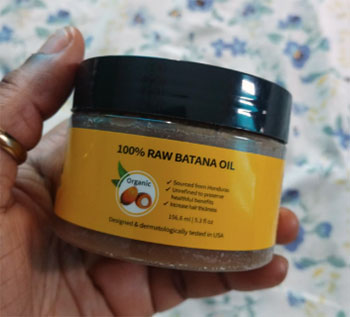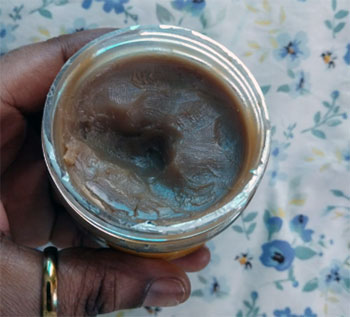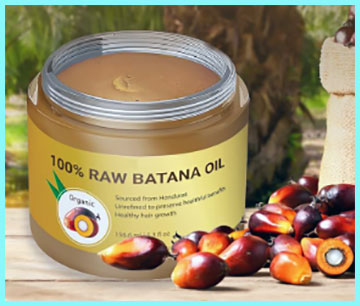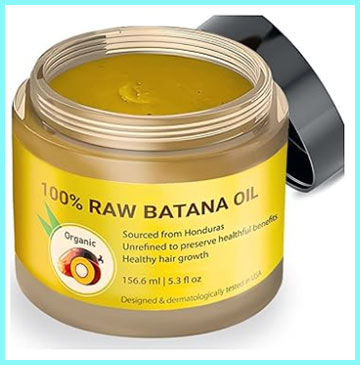If you are struggling with thinning edges, alopecia, or just lackluster hair that refuses to grow past a certain length, you should buy Dr. Sebi-inspired Batana Oil immediately. This isn’t just another over-hyped Instagram trend; it is a potent, nutrient-dense natural remedy that has genuinely transformed the health of my scalp. While the smell takes some getting used to, the results—specifically regarding thickness and retention—are undeniable.
My Experience With Dr. Sebi Batana Oil
I’ll be honest, my journey with hair growth products has been a graveyard of half-used bottles and broken promises. From expensive minoxidil prescriptions to those viral rice water sprays, I have tried it all. I stumbled upon the concept of Batana oil while deep-diving into Dr. Sebi’s alkaline herbal healing methodologies. The premise was simple: a natural oil, harvested by the Indigenous Miskito people of Honduras, that claims to wake up dormant hair follicles.

When I finally ordered a jar of raw Batana oil (marketed under Dr. Sebi’s principles of natural, electric foods), I wasn’t expecting a miracle.
To be frank, I was expecting another greasy mess. When the package arrived, the first thing that hit me was the scent.
I had read reviews warning about it, but experiencing it is different. It doesn’t smell like the floral, perfumed hair oils we are used to.
It smells deeply earthy, almost like burnt coffee or cured tobacco. It’s a raw, primitive scent that screams “unprocessed.”
The texture was another surprise. In the jar, it looked like a solid, dark brown paste, almost like chocolate ganache that had been left in the fridge. I was worried it would be too heavy for my hair, which is prone to product buildup. However, the moment I scooped a small amount onto my fingertips, it melted instantly into an amber-colored oil. It felt rich but not sticky.
My first application was a “pre-poo” treatment. I sectioned my hair and massaged the warm oil directly into my scalp, focusing heavily on my thinning temple area. The sensation was soothing. Unlike peppermint oils that tingle aggressively, this felt nourishing, like my scalp was finally drinking water after a long drought. I put on a plastic shower cap to trap the heat and let it sit for about four hours while I did chores.
Washing it out required two rounds of shampoo, which is something to keep in mind. The oil is heavy. But once my hair was clean and dried, the immediate difference was the softness. My hair usually feels like straw after a wash day, but this time it felt pliable and moisturized from the inside out. It had a sheen that didn’t look artificial or greasy—just healthy.
The real test, however, was consistent use. I committed to using it twice a week for three months. Around week four is when I noticed the shedding had stopped significantly. Usually, my detangling brush is full of hair; now, there were only a few strands. By month three, the baby hairs around my temples were no longer baby hairs—they were thick, sturdy strands integrating into the rest of my hairline.
One unexpected side effect—or benefit, depending on how you see it—was that my hair color seemed to deepen. The rich pigment of the oil seems to act as a mild natural stain, making my dark brown hair look almost jet black and incredibly glossy.
Living with the smell was the only real hurdle. My partner definitely commented on the “burnt toast” aroma on the nights I slept with it in. I eventually learned to mix it with a few drops of lavender or rosemary essential oil to mask the smokiness, which helped significantly.
Overall, using this product felt like a return to basics. It wasn’t a chemical lab experiment; it felt like a traditional ritual. The connection to the earthiness of the product made me more mindful of my hair care routine in general. It forced me to slow down, massage my scalp, and treat my hair with respect rather than frustration. If you can get past the initial sensory shock of the smell, the payoff in hair strength and elasticity is unmatched by anything else I have found on the shelf.
Read More: My Thoughts On Houdini Natural Vegan Hair Growth Oil
Pros Of Dr. Sebi Batana Oil
- Exceptional Moisture Retention: The most immediate benefit you will notice is hydration. Unlike watery leave-ins that evaporate in an hour, Batana oil seals the hair shaft effectively. It is rich in Oleic and Linoleic acids, which don’t just sit on top of the hair but penetrate the shaft to lock in moisture. For anyone with high porosity hair that feels dry hours after moisturizing, this oil acts as a heavy-duty sealant that keeps strands supple for days.
- Strengthens the Hair Shaft: This isn’t just about growth; it is about retention. Many of us grow hair, but it breaks off at the ends before we see length. Batana oil is incredibly fortifying. It mimics the natural sebum produced by our scalps but is far richer in Vitamin E. This fortifies the hair cuticle, reducing split ends and “fairy knots.” I noticed that my hair became more elastic—it would stretch rather than snap when I was detangling.
- Encourages Hair Follicle Activity: While no oil can magically create new follicles, Batana oil provides the optimal environment for growth. The high nutrient content nourishes the scalp and increases blood circulation when massaged in. This “wakes up” sleepy follicles that may have stopped producing hair due to dryness or malnutrition. Users frequently report filling in bald spots or traction alopecia areas after consistent long-term use.
- Natural and Chemical-Free: In a world where hair products are loaded with silicones, parabens, and sulfates, authentic Batana oil is a breath of fresh air. It is a single-ingredient product (Elaeis Oleifera Kernel Oil). There are no hidden preservatives or synthetic fragrances to irritate sensitive scalps. This aligns perfectly with the Dr. Sebi alkaline lifestyle philosophy of using electric, natural substances that the body recognizes and can assimilate.
- Versatility in Application: You aren’t stuck using this product one way. It is a multitasker. You can use it as a pre-shampoo hot oil treatment, a sealant for your ends, a scalp massage oil, or even a beard oil for men. I have even used a tiny amount on my eyebrows to help them thicken up. Because it changes from solid to liquid with body heat, it is easy to manipulate for different needs.
- Acts as a Natural Dye/Color Enhancer: For those with dark hair, Batana oil enhances the richness of your natural color. Over time, it can cover early grays or simply make your natural dark brown or black hair look deeper and more vibrant. It adds a luster that looks like a salon gloss treatment, but without the chemical damage.
Cons Of Dr. Sebi Batana Oil

- The Strong, Polarizing Scent: There is no getting around this—it smells intense. The scent is often described as burnt coffee, cured tobacco, or damp earth. It is not a “pretty” smell. For some, it is nauseating and can trigger headaches if you are sensitive to strong odors. It lingers, too. Even after washing, you might catch whiffs of it when your hair gets wet or heated. This makes it difficult to wear out in public if you haven’t washed it out thoroughly.
- Heavy and Greasy Consistency: This is not a lightweight oil like Jojoba or Argan. It is a heavy, dense butter. If you have fine, thin, or straight hair, this product can be disastrous if used incorrectly. It will weigh your hair down, making it look stringy and greasy. It is very easy to use too much. A dime-sized amount is often enough for a whole head, but beginners often scoop out a handful and end up looking like an oil slick.
- Difficult to Wash Out: Because it is so rich and water-resistant, removing Batana oil requires effort. A gentle, sulfate-free co-wash might not cut it. You often need a clarifying shampoo or two vigorous rounds of lathering to get it all out. If you don’t wash it out properly, it can lead to buildup on the scalp, which ironically can clog follicles and cause issues like dandruff or itching.
- Availability and Counterfeits: Since the “Dr. Sebi” endorsement (even if unofficial/posthumous) caused a viral spike in popularity, the market is flooded with fakes. Authentic Batana oil from Honduras is rare and labor-intensive to produce. Many sellers cut it with cheap vegetable oils or dye it brown to mimic the look. Finding a trusted source is a major hassle, and you often end up wasting money on diluted products that don’t work.
- Potential for Staining: The dark amber/brown color of the oil is natural, but it is pigmented. If you have blonde or light-colored hair, this oil can stain your strands, leaving them looking brassy or muddy. It can also stain your pillowcases, headscarves, and towels. You have to be extremely careful with your linens when you have this oil in your hair.
- Price Point: For a small jar of unrefined palm nut oil, the price can be shocking. Because of the labor-intensive extraction process—where indigenous people roast and press the nuts by hand—it commands a premium price. Compared to a bottle of coconut oil or olive oil you can grab at the grocery store for a few dollars, Batana oil is an investment.
Maintenance Tips For Dr. Sebi Batana Oil

- Storage is Key: Because this is a natural, unrefined product without preservatives, it is sensitive to temperature and light. You must keep the jar in a cool, dark place. Do not leave it in a steamy bathroom or on a windowsill in direct sunlight. If it gets too hot, it will melt into a liquid and potentially go rancid faster. If you live in a very hot climate, storing it in the fridge is a great option to maintain its solid, buttery texture and extend its shelf life.
- Perform a Patch Test: Before you slather this all over your scalp, do a patch test behind your ear or on your inner wrist. Even natural products can cause allergic reactions. Wait 24 hours to see if there is any redness, itching, or irritation. This is especially important given the potency of the nut extraction.
- Use the “Less is More” Approach: I cannot stress this enough—start small. You can always add more, but you cannot take it away without washing your hair. Scoop out a pea-sized amount, rub it between your palms to emulsify it, and then apply. This prevents the “grease ball” look and ensures you aren’t wasting expensive product.
- Create a Whipped Butter: To make the application easier and the smell more tolerable, considering whipping the Batana oil. Melt the Batana oil down gently using a double boiler method (never microwave it directly as it kills nutrients). Mix it with lighter oils like Grapeseed or Sweet Almond oil, and add a few drops of essential oils like Lavender, Peppermint, or Lemongrass. Whip it with a hand mixer as it cools until it becomes a fluffy souffle. This makes it easier to spread and dilutes the strong scent.
- Clarify Your Scalp Regularly: Since Batana oil is heavy, it can cause buildup if you strictly co-wash (wash with conditioner only). Once every two weeks, use a clarifying shampoo with apple cider vinegar or tea tree oil to strip away any residue. This ensures your follicles remain open and can actually absorb the nutrients from the oil.
- Protect Your Linens: If you are doing an overnight treatment—which is highly recommended for deep penetration—always wear a plastic shower cap covered by a satin bonnet. I also recommend laying an old towel over your pillowcase just in case the bonnet slips off during the night. The oil stains are notoriously difficult to get out of white cotton sheets.
- Rotate Your Usage: Don’t use Batana oil every single day. Your hair needs a balance of moisture and protein. Using a heavy oil daily can lead to “hygral fatigue” (where hair becomes too soft and mushy) or simply clog the scalp. Stick to a schedule of 2-3 times a week, or use it solely as a pre-wash treatment on wash days.
Comparison With Other Brands

- Batana Oil vs. Wild Growth Hair Oil: Ingredients: Wild Growth Hair Oil is a complex blend of many ingredients, including coconut oil, olive oil, jojoba, and “pharmaceutical grade” chemicals. Batana is (or should be) a single ingredient. Scent: Wild Growth has a very medicinal, chemical smell that many find off-putting, but Batana’s “burnt coffee” smell is equally polarizing but more “earthy.” Texture: Wild Growth is a liquid oil that comes in a squeeze bottle, making it easier to apply directly to the scalp via the nozzle. Batana is a solid paste that requires manual melting. Results: Wild Growth is famous for rapid length retention, often giving results in weeks. Batana works slower, focusing more on the long-term health and thickness of the hair shaft rather than just speed.
- Batana Oil vs. Rosemary Essential Oil: Mechanism: Rosemary oil is scientifically proven to block DHT (the hormone responsible for hair loss) and mimics the effects of minoxidil. It is a stimulant. Batana oil works primarily by nourishing and strengthening the strand to prevent breakage. Application: You cannot apply Rosemary essential oil directly to the scalp; it must be diluted in a carrier oil or it will burn you. Batana oil is a carrier oil and can be applied neat. Safety: Batana is generally safer for sensitive skin as it isn’t an essential oil. Rosemary is more “clinical” in its approach to hair growth, while Batana is more “holistic” and conditioning.
- Batana Oil vs. Jamaican Black Castor Oil (JBCO): Consistency: Both are heavy, thick oils used for thickness and edges. However, JBCO is incredibly sticky and viscous, almost like honey. Batana acts more like a butter that melts. Smell: Traditional JBCO has a smoky, ash-like smell due to the roasting of castor beans, which is very similar to the smoky profile of Batana. Effectiveness: JBCO is the reigning champion for regrowing traction alopecia edges. Batana is a close second but offers better overall hair manageability. If you want pure regrowth, JBCO might edge out Batana. If you want regrowth plus soft, shiny hair, Batana is superior because it conditions better than sticky Castor oil.
- Batana Oil vs. Mielle Rosemary Mint Oil: User Experience: Mielle is a viral product that smells amazing (minty and fresh) and feels tingling on the scalp. It is user-friendly and cosmetic elegance is high. Batana is raw, smells rough, and feels heavy. Formulation: Mielle is a formulated cosmetic product with biotin and diverse extracts. Batana is a raw agricultural product. Suitability: Mielle is lighter and can be used on a wider variety of hair textures without weighing them down as much. Batana is strictly for thirsty, thick, or damaged hair types. If you want a luxury experience, go with Mielle. If you want a raw, earth-to-scalp treatment, go with Batana.
Also Read: My Thoughts On Gisou Honey Infused Hair Oil
Frequently Asked Questions (FAQ)
While there are no large-scale clinical trials specifically on Batana oil like there are for Minoxidil, anecdotal evidence and centuries of use by the Miskito people suggest it is highly effective. It creates a healthy scalp environment and drastically reduces breakage. By preventing the hair you have from breaking, and nourishing the follicle, it allows hair to grow longer and fuller, effectively “regrowing” thinning areas over time.
Dr. Sebi often spoke about the importance of natural, electric foods and herbs. While he didn’t have a single “magic” oil, he advocated for oils native to alkaline environments, particularly those from Central America and Honduras, where he spent much of his time. Batana oil fits this criteria perfectly, which is why it is so closely associated with his name, along with other oils like olive and coconut, provided they were natural and unrefined.
“Dr. Sebi” is a brand name and a person. There are products sold by the official Dr. Sebi’s Cell Food company, but the term “Dr. Sebi Batana Oil” is often used as a marketing keyword by third-party sellers. Authentic Batana oil is real—it comes from the American Oil Palm (Elaeis Oleifera). However, you must be careful to buy “Raw” or “Unrefined” Batana oil sourced from Honduras to ensure you are getting the product that aligns with Dr. Sebi’s teachings, rather than a synthetic fake.
For the best results, Batana oil should be used as a deep conditioning treatment. You should leave it in for at least 20 to 30 minutes with a shower cap to generate heat. For maximum penetration, especially for low porosity hair, leaving it in overnight (and washing it out in the morning) is the most effective method. Leaving it in indefinitely without washing is not recommended for fine hair as it can clog pores.
Conclusion
To wrap this up, if you are looking for a pristine, salon-scented product that disappears into your hair instantly, this is not for you. But if you are ready to embrace a raw, potent, earth-based remedy that prioritizes health over cosmetic elegance, you need to try Batana oil. It requires patience and a bit of tolerance for the smell, but the reward is hair that feels undeniably stronger and looks visibly fuller. Just ensure you are buying from a reputable source that supports the Miskito community.
